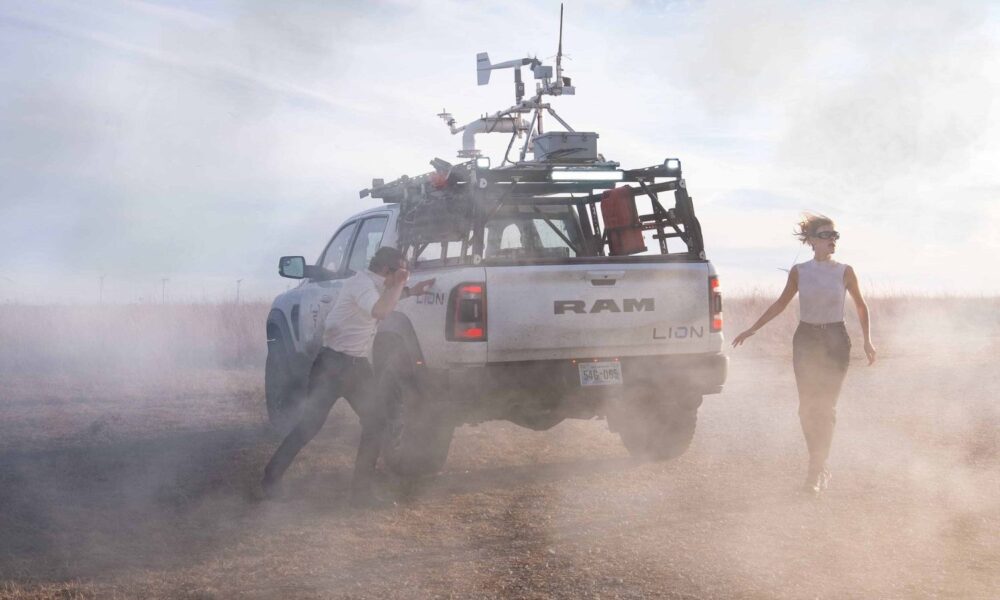A group of climate and energy experts and enthusiasts enters a theater to watch Twisters, hoping for a renewable energy twist. Little did they know they would be left chasing for more…
But really, as I entered the movie theater with my Chicago-based UCS colleagues and friends a week and a half ago, I knew we would be carefully watching the summer blockbuster for an accurate portrayal of our present situation: stark climate realities, Midwest experiences, and greatly impacted weather systems. Especially after 27 reported tornadoes in the Chicagoland area just this month, we all had high expectations for a story that connected all those realities—or at least a CGI-flying cow or themed popcorn bucket.
Here are our climate and energy perspectives on Twisters.

The characters that weren’t named
Tornado warning, spoilers ahead.
Although not explicitly named, climate change was a theme. And lurking in the background was our electricity system, a main character in the movie and one of the biggest contributors in real life to the climate pollution fueling more extreme weather events.
In the movie, we saw an oil refinery turn a tornado into a firestorm, and in contrast, we saw a tornado travel through a wind farm. Each scene depicts two very different stories and possible outcomes from a tornado ripping through a spot in the power system. With the windspeeds of a tornado colliding into an oil refinery, one could expect many more people to be devastated by the toxins emitted from the explosions. Fossil-fueled power plants are often located closer to population centers, presenting a significant health risk to residents in those areas—areas that are often lower-income or minority neighborhoods. (This reminds me of the train derailment in East Palestine, Ohio, where over a year later, “[e]xperts say it will likely take years and extensive research to understand the derailment’s health implications.”)
Compare that to the scene of the tornado zipping through a wind farm: according to the Department of Energy, the key differences between wind sources and fossil fueled plants are that “wind farms are built at a safe distance from populated areas and inhabited dwellings, and they are developed with thoughtful public engagement and thorough assessments of natural land features and hazards, local weather patterns, and historical data to minimize or eliminate negative impacts to wildlife and people. They often are built with safety features, such as emergency access and response routes, to ensure any issues that arise can be addressed quickly.”
This brings me to the next line in Twisters that jumped out at our group from UCS Chicago.…
“If you don’t have data, who’s going to believe it?”
This is what the character Javi, portrayed by Anthony Ramos, says to Kate, played by Daisy Edgar-Jones, when considering using their new data collection device for an approaching tornado. In another scene, the character Tyler, played by Glen Powell, says, “A tornado rating, it’s not based on size or wind speed—it’s based on damage.” My heart sank as I put it all into context.
According to The National Centers for Environmental Information, as of July 9, 2024, 15 severe weather and climate disasters have been confirmed this year, with losses exceeding $1 billion each. For context, the annual average is 8.5 disasters (CPI-adjusted) from 1980–2023. More importantly, that doesn’t account for the stress experienced by the communities, associated healthcare costs, disruption, displacement, and the impact of everything about their life changing after a disaster. Not to mention, this doesn’t include the ‘smaller’ scale weather events that carry just as much impact (e.g., extreme heat, flooding).
When I heard those lines I also thought about this: people are 22 times more likely to remember something if it has a story attached. I remembered our partners, Soulardarity, in Highland Park, Michigan. Highland Park is in the 92nd percentile for environmental injustice in Michigan. According to the report, residents of Highland Park experienced prolonged energy outages in 2021 during weather events—heat waves, winter storms—and the pandemic. This led residents to ask fundamental questions around energy sovereignty, like: ‘What if we empower communities to choose clean energy and generate electricity locally?’
But, as the movie alludes to, data isn’t the full story. Communities have been advocating and sharing their stories of how they are affected by extreme weather for quite some time:
“We could save lives.”
In Twisters, after losing mutual friends to a tornado, Javi convinces Kate to join his research team by helping her realize the lives that could be saved. And I’m here to convince you that this takeaway from Twisters is true off-screen, too. We all could collectively save lives by listening to the stories of those impacted by extreme weather events and fossil-fueled climate change and taking actions to help mitigate and prevent these events.
Communities across the country affected by extreme weather events or those in close proximity to polluting industries have been calling attention to their experiences for a long time. We must listen more to people directly affected, especially when it’s their stories that are fictionalized on-screen.
In the words of Kristy Dahl, UCS climate scientist: “The reality is that there have always been tornadoes. There have always been hurricanes. There have always been wildfires. These are some of the many ways the climate system releases and redistributes energy. We can’t prevent every extreme event, but we can be better prepared for them.”
And help prevent the worsening of them.
Responses to extreme weather events are traditionally very reactive, but there are ways to be better prepared and reduce the severity of the weather event, including creating more resiliency within our grid and within our communities. Extreme weather events require a wide range of actions, especially in the energy sector. We need to reduce our emissions and create a grid that can withstand, respond to, and recover rapidly from major power disruptions. This involves anticipating, preparing for, and adapting to changing grid conditions.
Just think about this: in 2022, 60% of US electricity was generated from burning fossil fuels, mainly coal and natural gas. However, unlike large, centralized coal and gas power plants on single sites, renewables such as wind and solar facilities are more distributed, spreading out the risk of direct storm impacts.
“If you feel it, chase it.”
While chasing tornadoes is not recommended, my colleagues and I left the theater knowing we can and should all be chasing a cleaner electric grid. It is as simple as voicing where our energy comes from. That can include participating in public hearings and getting involved with your state commission’s election process and state legislature, among other things.
There is a scene late in the movie when the characters are watching Frankenstein in a movie theater before a tornado rips the screen away, a likely symbol of our current moment.
Like Dr. Frankenstein, we’ve created this monster; we are responsible for our climate warming. And although not explicitly named in the film, my colleagues (and, well, science!) are here to name it for you: the movie is indeed about climate change. Like the characters and their twisters, recognizing and understanding the problem of climate change empowers us to make informed decisions and take decisive action. And you, yes, you, can do something about it; we can all be the hero of our story. So, say it with me: “If you feel it, chase it,” and represent your vote in the process.

